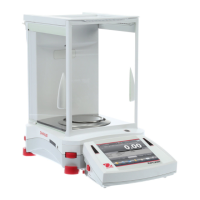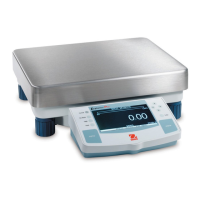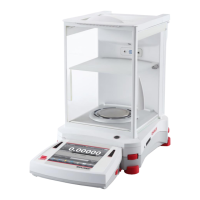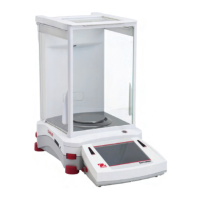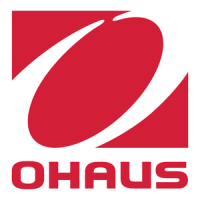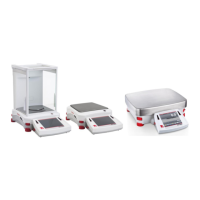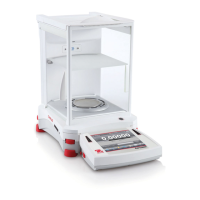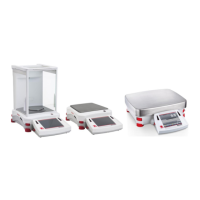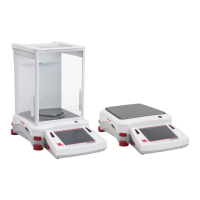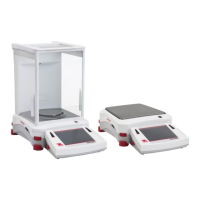Do you have a question about the OHAUS Explorer Balances and is the answer not in the manual?
Provides an overview of the service manual's contents and structure.
Details the environmental and workspace requirements for servicing balances.
Lists common hand tools, software, and test equipment needed for service.
Presents technical specifications for various Ohaus Explorer® balance models.
Explains the fundamental operation and user interface of the Explorer® balance.
Identifies key display elements, touch areas, and functional icons on the balance.
Details the balance's main menu structure and principal functions.
Describes how to navigate through the balance's menus and select options.
Explains the process for navigating and modifying balance settings.
Describes common icons and their associated functions for balance operation.
Details Legal For Trade settings and their impact on menu access and operation.
Outlines the overall menu hierarchy, including User and Diagnostics menus.
Describes the functions and icons available within the User Menu.
Explains how to access diagnostic features and verify component operation.
Explains the use of the slide switch for menu and key lock security.
Identifies the interactive areas on the balance's display screen.
Provides general procedures and a diagnostic guide for troubleshooting balance issues.
Discusses software-related issues, versions, and upgrade procedures.
Explains how to use the diagnostic guide to locate and fix probable causes.
Details regular cleaning, inspection, and care for Ohaus balances.
Provides general instructions for disassembling the Explorer® balance.
Procedure for replacing the load cell in specific Explorer® models.
Procedure for replacing the load cell in high capacity Explorer® models.
Details removing shipping protection screws after load cell assembly.
Instructions for replacing printed circuit boards, emphasizing ESD protection.
Instructions for removing and installing a new function label on the touch panel.
Procedure for replacing the touch panel, including related component replacement.
Details the process and components for replacing the balance feet assemblies.
Instructions for replacing the motor and its associated printed circuit board assembly.
Lists the required test masses and their quality classes for calibration.
Steps to verify the balance starts up correctly and check for errors.
Refers to Appendix B for testing the load cell using the RAMP function.
Describes tests to evaluate balance performance and accuracy after service.
A quick test measuring the deviation of weight readings for accuracy.
Measures standard deviation from weight readings to assess consistency.
Evaluates the linearity of the unit across its operating range using test masses.
Determines if displayed values are affected by sample placement on the pan.
Lists and illustrates spare parts for the balance's terminal module.
Lists and illustrates spare parts for non-draftshield balance base models.
Lists and illustrates spare parts for draftshield balance base models.
Lists and illustrates spare parts for high capacity Explorer® balance bases.
Lists and illustrates spare parts specifically for the draftshield assembly.
Instructions for performing span calibration using internal or external weights.
Discusses linearity calibration and refers to service linearization procedures.
Procedure for recalibrating the touch screen display.
Details diagnostic tools accessible by the user for component verification.
Describes the service sub-menu, requiring a password for access and advanced functions.
Lists commands used to send instructions to the balance via its interface.
Diagram and description of RS232 port pin assignments for connectivity.
Explains the USB interface, drivers, and connection process for the balance.
Step-by-step guide for upgrading the balance firmware using a USB flash drive.
Provides an overview of the service manual's contents and structure.
Details the environmental and workspace requirements for servicing balances.
Lists common hand tools, software, and test equipment needed for service.
Presents technical specifications for various Ohaus Explorer® balance models.
Explains the fundamental operation and user interface of the Explorer® balance.
Identifies key display elements, touch areas, and functional icons on the balance.
Details the balance's main menu structure and principal functions.
Describes how to navigate through the balance's menus and select options.
Explains the process for navigating and modifying balance settings.
Describes common icons and their associated functions for balance operation.
Details Legal For Trade settings and their impact on menu access and operation.
Outlines the overall menu hierarchy, including User and Diagnostics menus.
Describes the functions and icons available within the User Menu.
Explains how to access diagnostic features and verify component operation.
Explains the use of the slide switch for menu and key lock security.
Identifies the interactive areas on the balance's display screen.
Provides general procedures and a diagnostic guide for troubleshooting balance issues.
Discusses software-related issues, versions, and upgrade procedures.
Explains how to use the diagnostic guide to locate and fix probable causes.
Details regular cleaning, inspection, and care for Ohaus balances.
Provides general instructions for disassembling the Explorer® balance.
Procedure for replacing the load cell in specific Explorer® models.
Procedure for replacing the load cell in high capacity Explorer® models.
Details removing shipping protection screws after load cell assembly.
Instructions for replacing printed circuit boards, emphasizing ESD protection.
Instructions for removing and installing a new function label on the touch panel.
Procedure for replacing the touch panel, including related component replacement.
Details the process and components for replacing the balance feet assemblies.
Instructions for replacing the motor and its associated printed circuit board assembly.
Lists the required test masses and their quality classes for calibration.
Steps to verify the balance starts up correctly and check for errors.
Refers to Appendix B for testing the load cell using the RAMP function.
Describes tests to evaluate balance performance and accuracy after service.
A quick test measuring the deviation of weight readings for accuracy.
Measures standard deviation from weight readings to assess consistency.
Evaluates the linearity of the unit across its operating range using test masses.
Determines if displayed values are affected by sample placement on the pan.
Lists and illustrates spare parts for the balance's terminal module.
Lists and illustrates spare parts for non-draftshield balance base models.
Lists and illustrates spare parts for draftshield balance base models.
Lists and illustrates spare parts for high capacity Explorer® balance bases.
Lists and illustrates spare parts specifically for the draftshield assembly.
Instructions for performing span calibration using internal or external weights.
Discusses linearity calibration and refers to service linearization procedures.
Procedure for recalibrating the touch screen display.
Details diagnostic tools accessible by the user for component verification.
Describes the service sub-menu, requiring a password for access and advanced functions.
Lists commands used to send instructions to the balance via its interface.
Diagram and description of RS232 port pin assignments for connectivity.
Explains the USB interface, drivers, and connection process for the balance.
Step-by-step guide for upgrading the balance firmware using a USB flash drive.
| Readability | Varies by model (0.1 mg to 1 g) |
|---|---|
| Calibration | Internal or external, depending on model |
| Connectivity | RS232, USB (host and device), Ethernet |
| Power Supply | AC adapter |
| Units | g, kg, lb, oz, ct |
| Stabilization Time | Typically 2-3 seconds |
